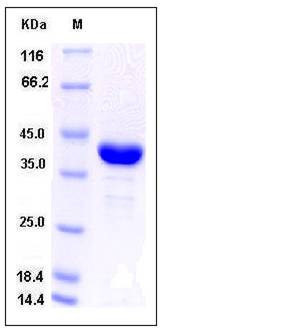Human AKR1A1 Protein (His Tag)
ALDR1,ALR,ARM,DD3,HEL-S-6
- 100ug (NPP1881) Please inquiry
| Catalog Number | P11607-H07E |
|---|---|
| Organism Species | Human |
| Host | E. coli |
| Synonyms | ALDR1,ALR,ARM,DD3,HEL-S-6 |
| Molecular Weight | The recombinant human AKR1A1 consisting of 341 amino acids and migrates as an approximately 39 kDa band in SDS-PAGE under reducing conditions as predicted. |
| predicted N | Met |
| SDS-PAGE |  |
| Purity | > 90 % as determined by SDS-PAGE |
| Protein Construction | A DNA sequence encoding the human AKR1A1 (P14550) (Met 1-Tyr 325) was expressed, with a polyhistidine tag at the N-terminus. |
| Bio-activity | |
| Research Area | Cancer |Signal transduction |Metabolism |Alcohol metabolism |
| Formulation | Lyophilized from sterile PBS, pH 7.5 1. Normally 5 % - 8 % trehalose and mannitol are added as protectants before lyophilization. Specific concentrations are included in the hardcopy of COA. |
| Background | Aldehyde reductase (AKR1A1) is a member of the aldo-keto reductase superfamily, which consists of more than 40 known enzymes and proteins that includes variety of monomeric NADPH-dependent oxidoreductases, such as aldehyde reductase. Aldehyde reductase has wide substrate specificities for carbonyl compounds. These enzymes are implicated in the development of diabetic complications by catalyzing the reduction of glucose to sorbitol. Aldehyde reductase possess a structure with a beta-alpha-beta fold which contains a novel NADP-binding motif. The binding site is located in a large, deep, elliptical pocket in the C-terminal end of the beta sheet, the substrate being bound in an extended conformation. This binding is more similar to FAD- than to NAD(P)-binding oxidoreductases. AKR1A1 is involved in the reduction of biogenic and xenobiotic aldehydes and is present in virtually every tissue. |
| Reference |
